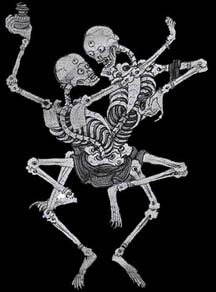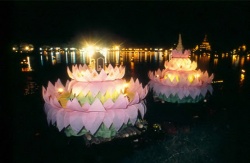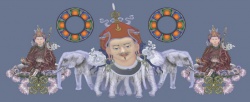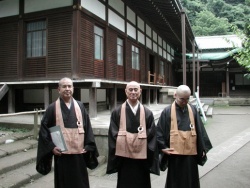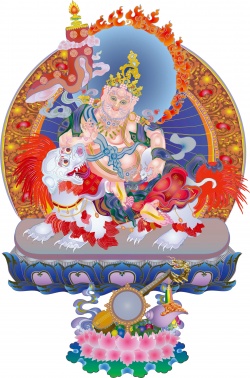On Tibetan Buddhism
Dzogchen is the main practice of Nyingmas, generally speaking, while for Kagyu it's Mahamudra. In Theravada, anapanasati can be practiced both way: as samatha, and as vipassana, depending on whether they are focusing on the in and out of the breathe or on the pure sensate reality and the 3 characteristics of the breathe. In Tibetan Buddhism however, even in Mahamudra, even if they are taught as the main practice for a beginner, they will at most be treated as a samatha technique to stabilize the mind before moving on to pointing out the nature of Mind. There is also less emphasis in samatha jhana in Tibetan Buddhism, where many teachers only advice their students to reach 1st Jhana and no more, before moving on to Insight. However to put it in perspective, Zen bashes samatha jhana even more than Tibetan Buddhism, sometimes even devaluing it into a state of Makyo (illusion). Anyway you can get a very good look at the Mahamudra meditation system in a book I and Thusness highly recommends: Clarifying the Natural State.
In my understanding, Theravadin Vipassana (Myanmar and Sri Lanka style -- Thai Forest is a little different) is not exactly similar as Zen koan training or Tibetan Dzogchen or Mahamudra system. Why? Vipassana emphasize the gradual unfolding insights, going through 16 nanas before culminating in a Fruition event which is a form of cessation. This is what I, Kenneth and Thusness calls the Gradual Path practice.
Then there is the Direct Path teaching, which emphasize pointing out and realising the nature of Mind. Since the nature of Mind is timeless instead of developmental, it is ever present regardless of what states, experiences, nanas you have been through, it can be discovered in the here and now. It is not the result of having progressed through certain experiences or insight stages and thus having achieved certain stage of experience, because it is always this Mind which is the basis of All experiences, that is why it is beyond effort but can only be realised or recognised. The methods of Koan also aim at this. This does not mean that there is just one final insight and that's it -- however, the practitioner of, for example the 'Who am I' koan will first get an initial realisation of the I AM and from there, they can do more koans and move on to Non Dual, etc. That is why Zen is known as 顿悟 (Instantaneous Awakening) -- there must be the sudden, intuitive, unshakeable 'eureka!'-sort realisation of the 'I'. Awaken to this ‘I’, the path of spirituality becomes clear; it is simply the unfolding of this ‘I’. The Vipassana practitioner of the Gradual Path (i.e. Mahasi Sayadaw style Vipassana, not Thai Forest style which did teach Direct Path in some way) however, will not realise anything of 'intrinsic luminosity of Mind', 'primordial Awareness', etc, until Anagami. That means the Fruition event in Sotapanna & Sakadagami has nothing to do with the I AM or Non-Duality. But more on that later.
I should also mention, the practice emphasized in Gradual Path (i.e. noting, observing 3 characteristics of phenomena) is also different from the practices emphasized in the Direct Path (depending on tradition: self-inquiry, koan, pointing out nature of mind and sustaining recognition, formless meditation, etc).
The Theravadin tradition, following the gradual system of samatha-vipassana combined, as I said earlier basically climbs up the 16 nanas, and then reaches the Fruition event and attains Sotapanna.
What is the difference between realising Mind, and attaining Fruition? It's different. I'll paste some excerpts from Kenneth Folk on the difference at the bottom of the post.
However where it all converges is: Anagami. An Anagami who followed the traditional Theravadin path may not go through certain stages of experience in the Direct Path, like the I AM, but at the Anagami level the person will realise non-dual awareness beyond subject and object division, even if he follows strictly the Gradual Path, similar to a practitioner who follows Direct Path and eventually lands up in Non Dual insight. That practitioner or Anagami will then be able to apply his insights more and more into daily lives rather than in the cessation event, and be able to perceive emptiness, impermanence, selflessness, non-dual intrinsic luminosity, etc. in real time in his entire sensate universe. The most subtle dualities and attachment to a Self agent in any subtle way/the final knot of the centerpoint is finally removed at Arhantship.
By the way, I do not think Direct Path is necessarily 'better' than Gradual Path, and it simply depends on the practitioner -- one must guage one's conditions. Kenneth recommends somehow ballancing both (though it is not the same as practicing both at once: you cannot possibly do that -- one is abiding as the Timeless I AM without investigation, whereas the other is investigating the three characteristics of passing phenomena, but you can flip flop between them), however for me right now, I am focusing on the 'Direct Path'. In terms of statistics, I do not have them, but basically I see very successful and highly attained Gradual Path practitioners as well as Direct Path practitioners. No matter what path you practice, you still end up having to practice 10-20 years and more to realise and mature the insights. The initial glimpse is faster but it is not the end.
Question: What is the relationship between primordial awareness to fruition?
Answer: Experientially, not much. Fruition, according to the Mahasi school of Theravada Buddhism, is total cessation of the mind/body process. Subjectively, it's very much like being asleep. Primordial awareness is pure awakeness. It’s important to note here that Tibetan Dzogchen masters also use the word fruition, but they are not talking about Mahasi fruition; in Dzogchen, fruition is synonymous with rigpa, which is the recognition of primordial awareness.
Question: I just finished reading Sam Harris's book, The End of Faith, in which he claims to describe the universal essence of contemplative and mystical experience. It's strange, because what he calls the universal contemplative experience sounds like what people on this forum are calling primordial awareness or seeing emptiness, but he doesn't mention nirvana (cessation) at all in anything I've read by him. I'm wondering why he does that, if he really experiences emptiness but not cessation, or if he declines to write about nirvana in his mainstream writing career for other reasons (although, gee, writing about empty awareness is pretty weird on the scale of things).
Answer: This is an interesting question, and one that only someone well-versed in Theravada theory would ask. It would be difficult to find a reference to cessation/nibbana in the literature of any other tradition. Other traditions tend to emphasize the awake no-self experience over the erased-self experience of cessation. Assuming that people go through the same organic process of development whether they are targeting it or not, then everyone will experience the developmental landmark of cessation as defined by the Mahasi school. On the other hand, if you aren't looking for cessation and/or haven't been told that it is significant, it's just another of the thousands of things that can happen during a meditator's day.
Mahasi teachers love cessation because it helps them locate students on the map. Furthermore, Mahasi Sayadaw taught cessation as something to be cherished and cultivated. But even within Theravada there are teachers who don't believe that cessation should even be considered Nibbana. There is no one way to interpret these phenomena. What we know for sure is that First and Second Path, as defined by the Visuddhimaga, each culminate in a moment of cessation. So, for map-mongers, cessation is an important landmark.
I would not evaluate the enlightenment of people from other traditions based on whether they mention cessation, as to do so would lead to the mistaken impression that only Theravada Buddhists get enlightened. In fact, I used to read J. Krishnamurti and imagine that he was talking about cessation when he described his no-self experiences. He wasn't. I was just "shoehorning," i.e. trying to force other people's experience into the narrow framework of my own limited belief system.
.......
Answer: This is a matter of defining terms, and we'll need some serious disambiguation in order to make sense of all this. Two words in particular are problematic as they are used very differently in different traditions. The two words are fruition and vipassana.
Fruition, as defined by the Burmese Mahasi school, means cessation of the mind/body process. They also call this nibbana. It is a non-experience, a winking out of consciousness. It is nonetheless, very blissful; upon emerging from this state, you know you were someplace very nice, you just can't say where. It is this cessation that marks the Path moment and permanently changes your experience of the world and your meditation practice.
Fruition in the Dzogchen tradition is rigpa. Not at all the same as cessation. Rigpa is the wide-awake recognition, in the moment, of buddha nature within your own mind. Although it is the most highly prized of attainments according to direct path teachings, it does not represent any developmental milestone and does not complete any of the 4 Paths. Rather, it is the the perfect recognition and expression of what everyone already is—pure, untrammeled, primordial awareness. Direct path teachings consider this to be more significant than any developmental stage or phenomenon, as to recognize rigpa is to know the mind of all the Buddhas. It will be best if we can specify which definition of fruition we mean at any given time.
"Vipassana," as used by the Theravada tradition, is a technique for investigating the three characteristics of suffering, impermanence, and no-self. The same word (often spelled Vipashyana, which is Sanskrit as opposed to Pali), is used in the Dzogchen tradition to mean "letting be in the nature of dharmata" (Shri Singha, Quintessential Dzogchen, 113, ed.Kunsang & Binder Schmidt). In fact, the word "vipashyana" is used in various ways with various qualifiers within the Tibetan system, so it's important to know the context.
......
Question: I can't help but notice that your two fruitions are in fact mutually exclusive. If there is no consciousness, then there is no rigpa. Accordingly, rigpa is not unborn, for it ceases.
Answer: Yes, rigpa and cessation are mutually exclusive. One doesn't happen from the point of view of the other. But, remember, rigpa is the recognition of buddha nature in the moment. During that recognition, in my experience, cessation does not occur. But that does not mean that cessation does not happen within buddha nature; of course it does. It just happens at a time when buddha nature is not being recognized.
You can learn to access either kind of fruition, whenever you want. In the case of rigpa, the access is instantaneous, as soon as you remember to notice it. In the case of cessation, it may take a second or two, or, if you are very distracted, several seconds. Then you can compare rigpa and cessation side by side.
One practical detail is that you can let be in rigpa while you are driving, or eating dinner with the family, or in a meeting at work, whereas, at least for me, cessation usually requires closing my eyes. I usually roll my eyes up into my head, too, and flicker my eyelids, so I have to be discreet so people around me won't think I'm having a seizure. :-)
Back to the theory: you wrote, "rigpa is not unborn, for it ceases." If by ceasing, you mean that we aren't always aware of it, the same would apply to nibbana/cessation. So, I don't think that proves it ceases. Actually, buddha nature cannot be found to cease; since it is awareness itself, how would we know if it ceased? You can't be aware of not being aware.
